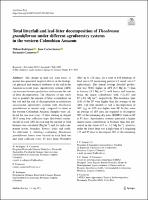Total litterfall and leaf‑litter decomposition of Theobroma grandiflorum under different agroforestry systems in the western Colombian Amazon
Fecha de publicación
2023Autor
Casanoves, Fernando
Tipo
Artículo
Metadatos
Mostrar el registro completo del ítemResumen
The objective of this study was to quantify the amount of litter accumulated on the soil and the rate of decomposition in multistrata successional agroforestry systems with Theobroma grandiflorum as mainly crop, compared to forest in the western Colombian Amazon. Samples were collected for one year every 15 days starting in August 2013 using four collection traps distributed systematically in each AFS. In each trap the amount of total biomass was calculated (Mg ha−1) and for each component leaves, branches, flowers, fruits and seeds.To determine k, litterbags containing Theobroma grandiflorum leaves were located in each land use and were collected every 15 days from November 2013 up to 150 days, for a total of 840 litterbags (6 land uses × 10 monitoring periods × 2 mesh size × 7 replications). The annual average litterfall production was 50.8% higher in AFS (6.5 Mg ha−1) than in forestry (3.2 Mg ha−1), with leaves and branches being the major contributors with 5.2 ± 0.5 and 0.7 ± 0.2 Mg ha−1, respectively. The residence time (1/k) of the SF were higher than the average of the AFS. The time needed to rich a decomposition of 50% (t50) in AFS was higher than SF. In this sense an average of 185 days are required to decompose
50% of the remaining dry mass (RDM%) while in SF is 95 days. Agroforestry systems generated a higher
annual mean contribution of biomass than that presented in the forest (6.5 vs. 3.2 Mg ha−1), however,
under the forest there was a high value of k. requiring 125 and 95 days to decompose 50% of the remaining dry mass. The leaf was the main contributor to the total biomass supplied to the soil.
Palabras clave
Editor
Springer
Es parte de
Agroforestry Systems
Status
openAccess
URI enlace
https://doi.org/10.1007/s10457-023-00876-6


